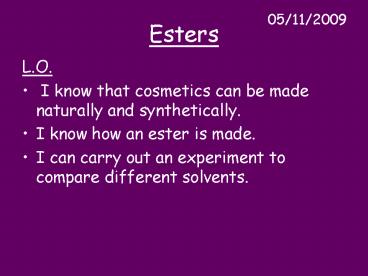Esters - PowerPoint PPT Presentation
1 / 10
Title:
Esters
Description:
I know how an ester is made. I can carry out an experiment to compare different solvents. ... e.g. roses, lavender and pine trees. Making Esters - Esterification ... – PowerPoint PPT presentation
Number of Views:213
Avg rating:3.0/5.0
Title: Esters
1
Esters
05/11/2009
- L.O.
- I know that cosmetics can be made naturally and
synthetically. - I know how an ester is made.
- I can carry out an experiment to compare
different solvents.
2
Starter
- In backs of books name 10 things that have
perfume added to them
Air freshener
Shampoo
Deodorant
Disinfectant
Washing up liquid
Candles
Body spray
Fabric Conditioner
Hair spray
Conditioner
3
What Makes a Good Perfume
Non-toxic
Does not poison
Does not irritate the skin
Can be put directly on the skin
Does not react with water
Does not react with perspiration
Evaporates easily - volatile
Perfume particles can reach the nose
Cannot be washed off easily
Insoluble in water
4
Volatility
- We can smell an ester because particles leave the
ester, diffuse through the air and stimulate
sensors in our nose. - The volatility (ease of evaporation) of perfumes
(esters) can be explained using ideas about
moving particles.
Movement of particles
DIFFUSION
low concentration
high concentration
5
How are Cosmetics and Perfumes Made?
- Cosmetics and perfumes can be made
- from natural sources. (can you name any?)
- For large scale cosmetic production perfumes are
more commonly made synthetically ( made by human
action)
e.g. roses, lavender and pine trees
6
Making Esters - Esterification
- To make a perfume a chemical called an ester is
- made. An alcohol mixed with an acid makes an
ester. - Alcohol Acid Ester Water
- This reaction is reversible (it goes both ways).
ethanol
propanoic
ethyl propanoate
butanol
butyl ethanoate
ethanoic
propyl butanoate
butanoic
propanol
methanol
ethanoic
methyl ethanoate
7
Uses of Esters
- Esters can be used for-
- Food flavourings
- Solvents
- Perfumes
8
Comparing Solvents
- Aim To find the best solvent to dissolve nail
- polish.
- Method
- A strip of nail polish was painted onto a
- wooden spill and put into these solvents.
Write up the results and a conclusion for this
experiment
hot water
ethanol
propanone
9
Homework
- Complete the sheet
- Solutions definitions to learn
- to recap for a quick test next lesson
10
Explaining the results
- Water does not dissolve nail varnish. This is
- because the force of attraction between two water
molecules is stronger than that between a water
molecule and a molecule of nail varnish.
Weak forces of attraction between water molecule
and nail varnish molecule.
Strong forces of attraction between nail varnish
molecules.
Strong forces of attraction between water
molecules.
11
Making a Perfume
- ESTERS Ethyl ethanoate, an ester, is formed by
the reaction of ethanoic acid with ethanol e.g. - ethanoic acid ethanol ethyl ethanoate water
- H2O
- Its an equilibrium, and starting with the pure
acid plus pure alcohol you get about 2/3rds
conversion to the ester, and the reaction is
catalysed by a few drops of concentrated
sulphuric acid. - This means a yield of about 67 in the 'atom
economy'. - If the ester is warmed with water or any dilute
acid (faster), it changes back into the original
acid and alcohol. This reverse reaction is called
hydrolysis i.e. - ethyl ethanoate water gt ethanoic acid
ethanol - whereas esterification is
- ethanoic acid ethanol gt ethyl ethanoate
water - (more on reversible reactions and chemical
equilibrium) - Esters are usually sweet smelling and widely used
as fragrances (e.g. perfumes) and food
flavourings































